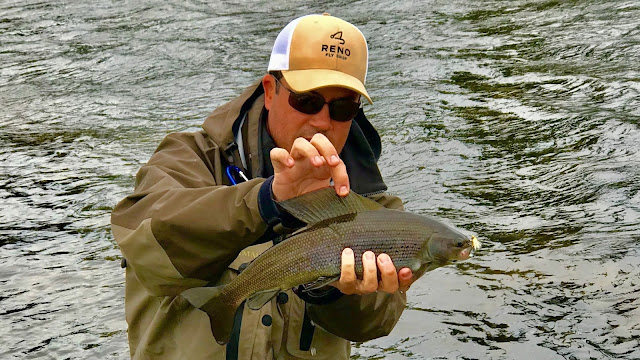Touted as the most northern sport fishery in the world, the Tree River and its largest strain of sea-run Arctic Char on the planet has been on my fly fishing bucket list for sometime. Located in the northern most reaches of Nunavut Territory in Canada, at nearly 68 degrees north, you're further north than Iceland. At this latitude, summers are brief if they exist at all and the entire fishing season lasts only 8 weeks.
The Lodge is operated by Plummer's Arctic Lodges and there is no logistically practical or financially viable way to reach this fishery but to go through them. They operate a top notch operation and employ first class fishing guides, but as this is a satellite operation serviced from their main facility some 220 miles southwest on Great Bear Lake (see prior post), don't expect the Ritz. Accommodations are comfortable and family style dinning is offered in a modest communal building, but lodging consists of wood floored canvas "tent cabins" heated by diesel stoves and rest facilities consist of outhouses. Nunavut is roughly the same size as Alaska, however, has 1/20th the population. All things considered, its pretty impressive the level of amenities offered in this no-man's land.
Originating from a chain of lakes 40 miles to the south, the river is absolutely violent generating several class III, IV and V rapids before terminating the in the Arctic Ocean. The char are believed to live much of the year in the Arctic Ocean where forage is abundant before making a 6+ mile journey up the river to spawn, ultimately being stopped by a 25 ft high Class V waterfall dubbed "Third Falls".
While most guests fish conventional tackle, we intentionally booked the lodge's 13th annual fly fishing week and as such, were paired with a very knowledgeable fly fishing guide. Our week constituted the 7th of 8 weeks of angling on the river, and we leaned the 8th week is reserved exclusively for 2 groups of sportsmen, 6 anglers for the Tree River and 6 hunters seeking trophy Musk Oxen. The lodge boasts 12 of 13 Boone and Crocket records.
While there is 6+ miles of river holding sea-run char, water holding char and fishable waters are two different things. When we arrived at base camp on Great Bear Lake, the Tree River was blown out, chocolate milk and un-fishable. We coordinated with the Lodge manager to be on standby and two days later were whisked off on a turbo otter as the river had cleared but remained swollen and engorged. For this reason, and by my estimates, only 5-10% of the river was fishable by fly rod (pegged bead) and only 2% fishable via swinging steelhead flies on a spey. We were fortunate to land a number of quality char with both techniques.
Once you hook up, you'll be hard pressed to keep these fish out of the current. Once they make it into the current (and they will), tie up your running shoes. This double took us a few hundred yards down river. I was quite surprised to learn that bi-catch in the river includes lake trout which come down from the lakes in the head waters and can reach 30 pounds. I found out fist hand how futile it was to try and land such a large fish in such a torrent after chasing one down a particularly turbid portion of the river about a quarter mile before I realized I was still several hundred feet into my backing. For fear of loosing all of my gear including my fly line, I opted to break it off.
The fish hold in any section of soft water as they regain strength to continue their journey upstream. Often times you can see their red bellies illuminate in the turquoise water but they're spooky, and I found a long rod to be a valuable asset.
This is the "Presidential Pool", named after former President George H. W. Bush who favored this rare piece of relatively soft water.
I liken these fish to large steelhead both in angling challenge and fight.
At first glance I thought this was a small bear track, but upon closer inspection, realized it was a large Arctic Wolf. We came upon two packs and also saw grizzlies. This far north, there are no salmon runs and forage is scarce. Unlike Alaska where most animals encountered during the summer months are well fed due to bountiful salmon runs and game, these top predators are to be avoided whenever possible. Guides will turn around if they see a bear on the trail, bears don't see us as a curiosity as they do in Alaska, they see you more like a potential food source they may need to survive the winter which is right around the corner.
Hope you enjoyed this post, shoot me an email if you have questions about booking a trip like this!














